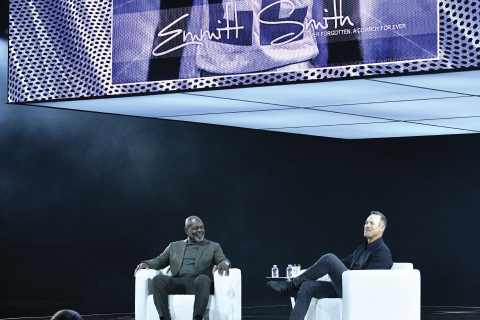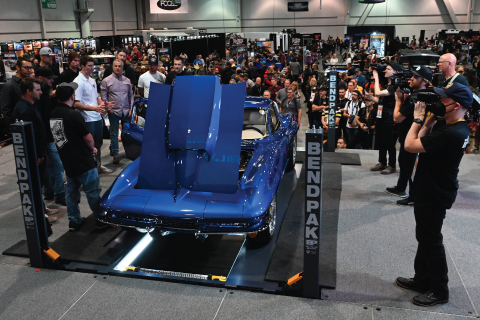EVENTS
Trendspotting at the 2021 PRI Trade Show
A Look at What’s New, Exciting and Fueling Growth in the Racing and Performance Sector
By Mike Imlay
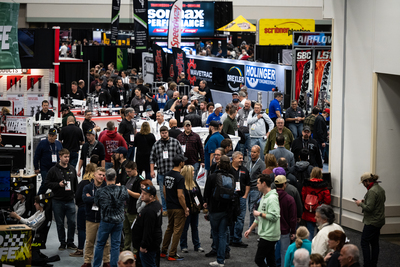
After a 2020 hiatus due to the COVID-19 disruptions, the Performance Racing Industry (PRI) Trade Show roared back to the Indiana Convention Center in Indianapolis this past December. The trade event offered a concentrated look at the industry’s latest trends and developments.
The Performance Racing Industry (PRI) Show is known across the racing and performance sector as a concentrated indicator of the industry’s latest developments and opportunities. After a forced hiatus due to COVID-19 in 2020, the 2021 trade event made its highly anticipated return to the Indiana Convention Center in Indianapolis, Thursday through Saturday, December 9–11.
The event drew more than 50,000 exhibitors, attendees and media representatives all eager to reconnect, do business and learn not only what the industry had been up to over the past two years but also how those developments might benefit their operations.
For SEMA and its member companies, the PRI trade event was especially significant. March marks the 10th anniversary of the transaction that brought the PRI Trade Show and publications under the SEMA umbrella. That strategic partnership has since seen PRI expand its role as an advocacy group to protect and grow racing.
“Racing is important to practically every automotive business, whether directly involved in motorsports or not, so SEMA extends its congratulations to PRI for what it has accomplished on behalf of everyone in the industry,” said SEMA President and CEO Chris Kersting. “For all of us in the specialty aftermarket, the PRI Trade Show was an impressive example of the passion we all share.”
So what’s new in the racing and performance world? The following are some key trends we observed in Indy.
Vehicle Electrification
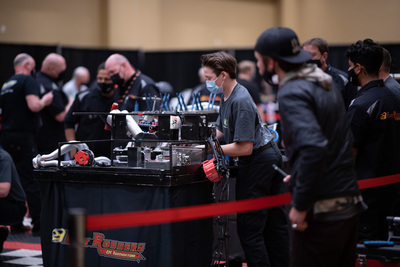
The PRI Trade Show demonstrated the high level of youth interest in all aspects of racing, including engine and car building. Pictured here, young attendees representing high schools from throughout the United States showcase their skills in the Hot Rodders of Tomorrow (HROT) engine-building championship.
At road courses, down dragstrips, around dirt tracks and even across the Bonneville Salt Flats, electric vehicles (EVs) have become a significant trend in the performance-racing sector. In part, this trend is being driven by OEM initiatives. Out of the top 20 global automakers—which together in 2020 represented around 90% of new-car registrations worldwide—18 have announced plans to rapidly scale up EV production in the coming decade.
Of course, motorsports have always been the proving ground for emerging technologies, and that spirit of engineering was on full display in the PRI Show EV Performance Zone, a feature area highlighting the growing EV presence in racing. The Zone’s exhibitors included Chevrolet Performance, Ford Performance and several aftermarket brands providing new products and solutions for the electrification market. In addition, purpose-built feature vehicles demonstrated the latest EV applications being introduced into Trophy Trucks, dragsters, motorcycles and other racing vehicles.
“Electrification is the future of the automotive industry, so we’re here to showcase the awesome power of our electric vehicles,” said Ford Performance Global Marketing Specialist Autumn Schwalbe.
Those vehicles included a Ford Cobra Jet 1400, Mach-E Mustang and ’78 F-100 concept pickup equipped with Ford’s Eluminator electric crate motor, which Schwalbe said has especially caught the attention of the racing industry.
“When we revealed the Eluminator, we sold a lot right away,” she said. “Whether for drag racing, short-course racing or small tracks, a lot of people are getting involved.”
Opposite the Ford exhibition, Chevrolet displayed a ’72 El Camino conversion built in partnership with Lingenfelter Performance Engineering and featuring the OEM’s e-crate system.
“We’re trying to give racers—and any individual—the opportunity to move toward an electric drive system,” said Mike Celotto, an assistant chief engineer with General Motors. “We know that electric drive is in its early stages. We expect it to grow just like the overall automotive industry is growing, so we want to have a space in that for our customers.”
Allen Thomas, president-elect of the National Electric Drag Racing Association (NEDRA), has been drag racing EVs for a decade now. While he also enjoys building and racing internal-combustion cars, Thomas said that the vehicle electrification movement reminds him of his early days in racing.
“I see the technological advancements,” he said. “I grew up during the heyday of drag racing, when there were different things hitting the dragstrip and incredible innovation and people building things. This is the feeling I get from building electric cars now—it’s back to the ’60s. It invigorates me because no one has a cookie-cutter approach.”
NEDRA is a coalition of electric drag racing vehicle owners, drivers and fans. The organization promotes EV manufacturers and parts suppliers while organizing and sanctioning electric drag events. Its exhibition at the show included two drag EVs.
“There’s going to be a lot of learning, a lot of challenges in electric drag racing, and it really draws me in,” Thomas said. “There’s exponential growth right now.”
Rob Ward, founder and CEO of Legacy EV, said that growth potential is pulling brands of all types into the EV space. A parts distributor for the EV market, Legacy was among several performance aftermarket companies educating showgoers about the emerging opportunities in the space.
“We’re working our tails off to be the face of aftermarket EV performance,” Ward said. “We’re working with more than 60 manufacturers right now to provide a complete electrification system for pretty much anything. There are a lot of companies investing a lot of energy and money into advancing complete EV systems, so we’re excited about where it’s headed.”
Other EV Zone exhibitors included Holley-AEM, Burrowmax, FirstCorner, HyperCraft, MRE Racing, ReVolt and Torque Trends. Key products in the category currently include EV control units, drive systems, gear-reduction boxes, battery packs and related components, but the field is ripe for all sorts of invention.
Diesel Motorsports
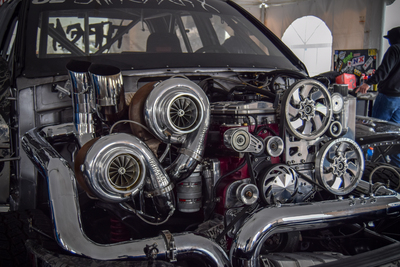
The growth, diversity and technical advancements found in today’s motorsports were on full display in Indianapolis. Among the many examples was diesel racing, which has become especially popular in recent years, leading to new opportunities for hardcore parts makers and performance suppliers.
Although diesel motorsports have been around for decades, the last five to 10 years have seen an explosion of fan interest. S&S Diesel Motorsport Co-Owner Luke Langellier believes that technological advancements are behind the category’s surge.
“If you think about the big picture, all the emissions regulations that the OEMs have had to abide by, that’s what pushed all this technology,” he said. “It would never have needed to exist if it weren’t for having to meet all those stringent requirements. That’s why we have trucks now that are perfectly quiet, make tons of power, tow like crazy and can do everything you want them to do.”
S&S Diesel’s exhibit space included a massive semi engine—a nod to the semi drag racing that’s become a major crowd pleaser.
“People love to race whatever they’re passionate about,” Langellier said. “We’ve got a pretty strong following of guys who are really passionate about getting as much performance from a semi as they can—in Canada and the northern United States, especially.”
Diesel Motorsports President Ron Knoch said that his organization’s drag races, sled-pulling and show-and-shine events continued unabated during the pandemic, partly because they’ve become popular staples of county fairs and similar family-friendly events, especially in the American heartland.
“Most people don’t know that there is a sled pull every night from June to the end of August in every state across what we call the ‘flyover states,’” he explained, adding that his organization’s races with five competitive classes are always well attended.
Greg Jolly, race director of the Outlaw Diesel Super Series, said that diesel truck events offer a unique thrill.
“For me, it’s watching them go down the track as fast as they do and as heavy as they are,” he said. “It takes a lot more horsepower and torque than it does on the car side of things, and it’s a lot harder on parts.”
In other words, things break a lot—which brings numerous opportunities for the performance aftermarket to produce everything from hardcore engine parts to heavy-duty suspension components.
“It’s pushing the limits and pushing the aftermarket to make better product,” he said.
Donk Racing
Few shows capture motorsports’ diversity like the PRI Trade Show, where there’s always something new and unexpected to encounter. Take for example, Donk, or big-wheel racing—a novel form of competition gaining serious traction in urban markets. At a seminar titled “Big Wheel Racing: Why It’s a Big Deal,” Sage Thomas (aka the Donkmaster) announced the formation of the National Donk Racing Association, a new sanctioning body bringing safety and organization to the rapidly growing niche.
What’s a Donk, you ask? Technically, it’s a customized ’71–’76 Impala or Caprice riding on 20-in. or larger wheels. (Preferably larger.) However, the term has become generic for similarly styled vehicles.
With Donk racing racking up millions of YouTube views and legions of social-media followers, Thomas believes the sport is opening new doors for sponsors, safety equipment suppliers, fabricators and parts makers—and of course, specialty wheel and tire makers.
“We’re showing people this is real, because a lot of big companies thought it was a fad,” Thomas said. “But it’s something new for the racetracks, for the fans and for supporters to be a part of something big. The opportunities are endless for small companies all the way up.”
Gridlife iRacing
PRI Trade Show attendees also got a look at Gridlife’s iRacer Experience, a new immersive racing concept designed to promote grassroots enthusiasm. The Gridlife booth feature consisted of six networked competition racing simulators running the latest iRacing build, complete with a live announcer broadcasting to online
enthusiasts.
According to Gridlife Creative Director Chris Stewart, the organization’s simulator competitions open motorsports to a gaming audience while teaching valuable track skills. Ultimately, that can encourage newcomers to embrace the racing lifestyle through the organization’s live track days, time-attack events, drifting events, education programs and festivals.
“Our intention is motorsports inclusion,” Stewart said. “We try to get people closer to motorsports—particularly younger individuals. Our core demographic is 18 to 38. We’re one of the youngest driving organizations globally.”
Youth in Motorsports
With the future of the performance industry hinging on attracting next-generation talent, PRI also made youth engagement a top show priority. On Friday, December 10, 2021, hundreds of young attendees gathered for the annual PRI Student Breakfast and Career Day, which connected students from across the United States with industry leaders. The exclusive meetings exposed the students to career opportunities ranging from team and shop roles to product development and administrative positions. The breakfast also served as an entrée to the Show’s world-class trade environment, where attendees could further take in the industry’s size and scope. Northwood University of Midland, Michigan, was among the many organizations participating in the event.
“Students come to Northwood to learn all about the automotive aftermarket,” said Michael Kinney, Northwood director of aftermarket curriculum. “We’re seeing a workforce in manufacturing—all the way down to service technicians—that is aging out and taking retirement. We need young people to come into the industry, and events like this show them how exciting it can be [with] a great future and great earning potential.”
Meanwhile, on the PRI Trade Show floor, exhibitor Preston Lewis was
promoting youth involvement through the Off-Road Motorsports Youth Foundation (OMYF). A survivor of childhood cancer, Lewis launched the nonprofit organization at the 2019 PRI Trade Show to give other youth affected by unfortunate life circumstances a taste of motorsports. OMYF is now building a desert racing team and a Class 7100 Unlimited Trophy Truck.
“Our growth has skyrocketed in the past couple of years after our first launch at PRI,” Lewis said. “Our sponsor list has increased drastically, and the quality of our sponsors has gone up quite a bit.”
Lewis expects the truck and the team to be race-ready by October 2022. He said OMYF came to the show to highlight alternatives for young adults who aren’t necessarily college-bound.
“What we’re trying to do is give them opportunities in a format where they can really find what they love,” he said. “If we could leave here with 15 to 20 kids who are really dedicated and want to be involved with us, that would be a win in our books.”
Young PRI attendees also demonstrated their building skills through the Hot Rodders of Tomorrow (HROT) competition, in which high school teams tear down and reassemble engines. The timed rounds took place over three days, with the Burton Center for Arts & Technology E3 Spark Plugs squad from Virginia taking 2021 National Champion honors.
“We had to shut the operation down for a year and a half due to COVID, and we thought it would be a great way to reboot it here,” said HROT President Rodney Bingham. “Just getting these students exposed to our performance racing industry shows them a whole new world of jobs and great careers that they could have.”
Led by instructor Chris Overfelt, the E3 Spark Plugs team scored an average time of 20 min. and 51 sec. Second place went to the Forsyth Central High School team sponsored by SCAT, which clocked in at 22 min. and 2 sec. The Moroso team from C.D. Hylton High School, finished third with a perfect engine build in 22 min. and 23 sec.
Growing Business
The PRI Show was also a prime venue for performance aftermarket manufacturers to discover new ways to sustain and grow their businesses. The possibilities for military contracts were discussed at a seminar titled “Army Ground Systems: Overview & How to Do Them.” Presented by Thomas Vern of the U.S. Army DEVCOM-Ground Vehicles Systems Center (GVSC), the workshop highlighted the synergy between motorsports and DEVCOM (Development Command) vehicle research and development.
“Anything on wheels, we handle it,” said Vern, who added that the GVSC is especially interested in several areas where the performance industry excels. They include EV technologies, heat dissipation, weight savings, suspension geometry, 3-D printing in metals, and parts-making for legacy items no longer mass-produced.
Business growth through content creation was also front and center at the show. The PRI Trade Show Content Creation Zone featured a Content Creator Stage Presented by Speed Sport with Ralph Sheheen. Throughout the week, onstage content creators educated attendees with tips for engaging audiences through success stories, insider news, introductions to gear and technologies, and hands-on demonstrations.
In addition, Justin Cesler of Driveline Studios presented the “WTF Is Content?!?” workshop, where he shared simple but effective tools for creating pro-level content for both traditional and new-media channels. According to Cesler, the biggest mistake a young brand can make is to sporadically post content or give up altogether due to sluggish response.
“Consistency is key,” he emphasized. “Don’t go out and make content one or two times and say it isn’t working.”
Protecting Motorsports
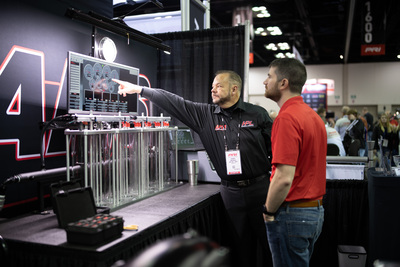
The PRI Trade Show’s return to a live format proved a successful reconnection for the industry, and a great deal of business was accomplished on the show floor. In addition, seminars, featured speakers and exclusive industry events inspired and primed attendees for the year ahead.
Since the recent U.S. Environmental Protection Agency (EPA) interpretation that the Clean Air Act prohibits motor vehicles designed for street use—including cars, trucks and motorcycles—from being converted into dedicated race cars, the entire performance racing industry has come under threat. In response, the 2021 PRI Trade Show included education on emissions compliance and action to pass the Recognizing the Protection of Motorsports (RPM) Act.
The RPM Act is bipartisan congressional legislation (H.R. 3281) designed to protect Americans’ right to convert street vehicles to dedicated race cars. It also protects the motorsports parts industry’s ability to make, sell and install products enabling racers to compete. The bill clarifies the legality of emissions-related modifications to street vehicles used exclusively in competition and reverses the EPA’s recent interpretation holding otherwise.
Industry support for the bill is strong, and two particular PRI events related to the issue were widely attended. The first was the Thursday “Update: RPM Act & Emissions Compliance” seminar, where a panel led by SEMA General Counsel David Goch presented steps for remaining compliant with EPA and California Air Resources Board requirements. The conference included a status update on the RPM Act and what performance and racing businesses could do to push it forward. Goch said critical mass for the legislation is building and passage is within grasp.
“What I have witnessed in my five years with the industry as general counsel is a true awakening and education,” he said after the seminar. “Five years ago, the questions were pretty rudimentary, such as, ‘What is the Clean Air Act and emissions compliance?’ Now people are asking more sophisticated questions to get a better understanding of what they need to do to comply. I think our future is bright, because my experience is that most of the folks that I touch through PRI are here
to learn to do it right and keep this industry strong.”
Friday evening, PRI also held a “Save Our Race Cars Rally” in the Quarterback Suite of Lucas Oil Stadium. The exclusive event offered further insights into the RPM Act and was open only to PRI Pro, PRI Champion and PRI Founding Members. PRI recently launched its membership program to help mobilize the industry and fundraise for the RPM Act and other initiatives to protect and grow the industry.
Among the speakers was Garrett Mitchell, aka Cleetus McFarland, a motorsports influencer with more than 1.2 million YouTube subscribers. He said that he was happy to lend his persona to the cause.
“A lot of these guys here are entrepreneurs,” he said. “Many of the people who sit in this room have their own businesses that are solely invested in the motorsports industry, which I can relate with because I have all my eggs in this basket, too. I just wanted to talk from my point of view and reiterate how important it is for us to all stick together.”
Ultimately, the 2021 PRI Trade Show was a testament to the industry’s continued innovation, grit and endurance, even through a pandemic.
“The racing industry is resilient and continues to push forward, and PRI very much reflects that spirit,” said PRI President Dr. Jamie Meyer. “Racing businesses have demonstrated remarkable passion and perseverance over the last year, and many even reported record sales and month-over-month revenue growth in 2021.”
Judging by what we just saw in Indy, the sector is again revved and ready to race forward in 2022.
Connecting With PRI
To get all the latest PRI developments, visit www.performanceracing.com where you’ll also find links to the PRI Trade Show, the recently launched PRI Business and Individual Membership programs that help protect the industry, and many other performance-racing business resources.


